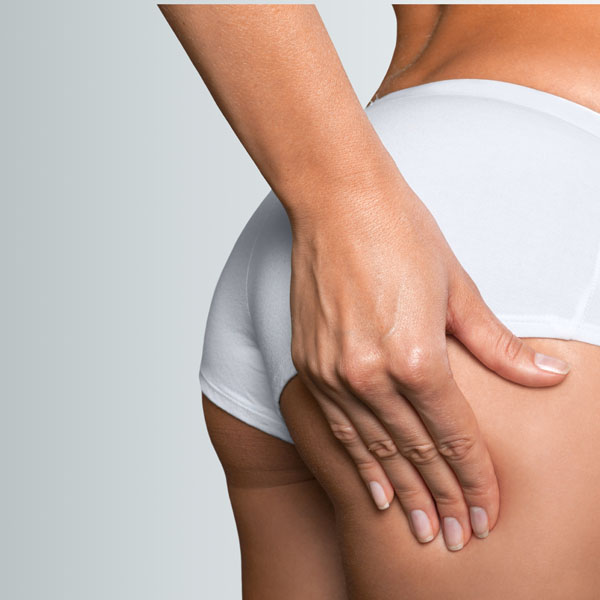By Doctor Jean-Marc Chardonneau
80% of women suffer from cellulite. Now that we better understand the factors responsible, and that the technologies used have evolved, we can offer more effective treatments.
There are two types of cellulite: superficial and deep. The superficial type is orange-peel syndrome, which is the result of excess pressure inside the walls that separate the fatty lobules, leading to abnormally high swelling and fibrosis. The cause seems to be in the micro-circulation, namely the capillary vessels being too permeable.
Deep cellulite is localised roundness. This is the result of excess localised fat.
A mathematical formula and therapeutic results
The micro-circulation seems to play a primordial role in the genesis of superficial cellulite (orange-peel syndrome). The studies I have carried out on high-resolution scans show that cellulite is located in the first 5-7mm of the skin. It is a kind of fibrous and oedematous magma, the result of a fight between dermal resistance (Rd) and the pressure (Psc) exerted by the most superficial sub-cutaneous layer.
Dermal resistance is primarily connected to the thickness of the dermis. The pressure of the sub-cutaneous tissue is connected to the presence of swelling, of fibres that expand the spaces between the walls of the adipose lobules. When the dermal resistance is lower than the pressure exerted by the superficial sub-cutaneous layer, there is cellulite = Rd < Psc.
In order to eliminate cellulite, we need to act in one of two directions: either increase Rd or decrease Psc. To increase dermal resistance, we need to bring about neocollagenesis (collagen production). Subcutaneous tissue pressure is connected to one factor: the pressure inside the interlobular walls. When the swelling and fibrosis are too great in this inflexible area (whose sides are limited by the adipose lobules), they exert high pressure on the lower part of the dermis.
The therapeutic aim for lowering this pressure is to reduce swelling and fibrosis.
Deep cellulite
This concerns the layer of fat located between the muscle and the superficial space underneath the skin (called the hypodermis). Liposuction is the go-to surgical treatment for deep cellulite and its effectiveness is undeniable, but nowadays patients want less invasive treatments that require no downtime, such as cryolipolysis. The theory behind cryolipolysis is that adipocytes are more sensitive to cold than the other skin cells. Thermoelectric pads extract the heat from the adipose panicle and cool it until it reaches a temperature of around 3-4°C. This cooling causes the lipids contained inside the adipose panicle to crystallise, leading the fat cells to die. This intense and prolonged cooling gives off the caspase 3 enzyme, which plays a central role in triggering the death of the fat cells, which are then slowly digested by the surrounding cleaning cells. This is the optimum medical treatment for excess localised fat. Many companies manufacture high-quality machines: Zeltiq, Deleo, MLS, etc.
Can orange-peel skin be treated?
The work led by Dr Szygula from the University of Opole (Poland) shows a significant improvement in the microcirculatory configuration of the cutaneous layers after a cryolipolysis treatment, with a reshuffling effect that was found to be ongoing when the configuration was checked 10 days after the final session. So, we understand that the microcirculation is disturbed when cellulite is created. This improvement in the tissues’ microcirculation optimises the vascular exchanges and therefore reduces swelling, but nevertheless only has a limited effect on the “orange-peel” appearance.
An intelligent innovation: cryolipolysis and shock waves
To achieve real results on superficial cellulite, we above all need to combat fibrosis: this is the job of shock waves. These are acoustic waves introduced into medicine over 20 years ago, as a treatment to remove kidney stones without damaging the skin or tissues. Shock waves are characterised by a sudden and transitory burst of high pressure. Following this burst of high pressure is a slightly longer phase of negative pressure, which is where the mechanical action of shock waves comes from. For cellulite, the aim is to break the structure of the interlobular spaces and therefore reduce the pressure between them. Shock waves also encourage collagen regeneration by improving the microcirculation. They can also be used to treat deep cellulite. By breaking the membrane around the fat cells, they encourage the triglycerides to leave the cell while at the same time activating an enzyme that eliminates triglycerides.
In our centre, we use the Cryowave device from MTD, which combines these two techniques to reduce localised fat and cellulite. The device has four cryolipolysis pads which can be placed on different areas of the body. I recommend having one cryolipolysis session every 45 days and shock wave sessions two or three times a week.
A Spanish study has just shown the effectiveness and safety of this therapy. We achieve a significant reduction in fat in 100% of cases (25% of the fat in the treatment area).
_____________________________________________
Doctor Jean-Marc Chardonneau
Angiology graduate from the French National College of Aesthetic Medicine, DIU (inter-university degree) in Obesity, Aging and Aesthetics of Superficial Tissue (Paris V). Graduated in Phlebology from the Paris V Marie Curie Institute and the French National College of Aesthetic Medicine (Paris VI). Inventor of the microsculpture and mesocannulation techniques for the legs. Consultant for FCARE, Solidea, Cutera Servier, etc.















